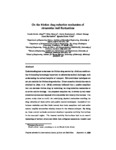On the friction drag reduction mechanism of streamwise wall fluctuations
| dc.contributor.author | Józsa, TI | |
| dc.contributor.author | Balaras, E | |
| dc.contributor.author | Kashtalyan, M | |
| dc.contributor.author | Borthwick, Alistair | |
| dc.contributor.author | Maria Viola, I | |
| dc.date.accessioned | 2021-08-22T10:54:45Z | |
| dc.date.available | 2021-08-22T10:54:45Z | |
| dc.date.issued | 2020-12 | |
| dc.identifier.issn | 0142-727X | |
| dc.identifier.other | 108686 | |
| dc.identifier.uri | http://hdl.handle.net/10026.1/17648 | |
| dc.description.abstract |
Understanding how to decrease the friction drag exerted by a fluid on a solid surface is becoming increasingly important to address key societal challenges, such as decreasing the carbon footprint of transport. Well-established techniques are not yet available for friction drag reduction. Direct numerical simulation results obtained by Józsa et al. (2019) previously indicated that a passive compliant wall can decrease friction drag by sustaining the drag reduction mechanism of an active control strategy. The proposed compliant wall is driven by wall shear stress fluctuations and responds with streamwise wall velocity fluctuations. The present study aims to clarify the underlying physical mechanism enabling the drag reduction of these active and passive control techniques. Analysis of turbulence statistics and flow fields reveals that both compliant wall and active control amplify streamwise velocity streaks in the viscous sublayer. By doing so, these control methods counteract dominant spanwise vorticity fluctuations in the near-wall region. The lowered vorticity fluctuations lead to an overall weakening of vortical structures which then mitigates momentum transfer and results in lower friction drag. These results might underpin the further development and practical implementation of these control strategies. | |
| dc.format.extent | 0-0 | |
| dc.language | en | |
| dc.language.iso | en | |
| dc.publisher | Elsevier BV | |
| dc.title | On the friction drag reduction mechanism of streamwise wall fluctuations | |
| dc.type | journal-article | |
| dc.type | Journal Article | |
| plymouth.volume | 86 | |
| plymouth.publication-status | Published | |
| plymouth.journal | International Journal of Heat and Fluid Flow | |
| dc.identifier.doi | 10.1016/j.ijheatfluidflow.2020.108686 | |
| plymouth.organisational-group | /Plymouth | |
| plymouth.organisational-group | /Plymouth/Faculty of Science and Engineering | |
| plymouth.organisational-group | /Plymouth/Faculty of Science and Engineering/School of Engineering, Computing and Mathematics | |
| plymouth.organisational-group | /Plymouth/Users by role | |
| plymouth.organisational-group | /Plymouth/Users by role/Academics | |
| dcterms.dateAccepted | 2020-08-23 | |
| dc.rights.embargodate | 2021-9-1 | |
| dc.rights.embargoperiod | Not known | |
| rioxxterms.versionofrecord | 10.1016/j.ijheatfluidflow.2020.108686 | |
| rioxxterms.licenseref.uri | http://www.rioxx.net/licenses/all-rights-reserved | |
| rioxxterms.licenseref.startdate | 2020-12 | |
| rioxxterms.type | Journal Article/Review |


